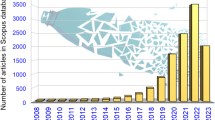Abstract
The existing methods for dewatering sewage sludge containing finely dispersed clay minerals can be applied with an initial moisture content of <75%. In the case of higher moisture content, it is necessary to treat preliminary such dispersions to provide their destabilization, sedimentation, and consolidation, that is, to obtain more concentrated precipitate, followed by the separation of the excess liquid phase. A decrease in the stability of clay disperse systems can be achieved by decreasing the electrostatic repulsion between particles with a decrease in their surface charge due to a change in the pH of the dispersed medium or adsorption of potential-determining cations, as well as due to the compression of the double electric layer with an increase in the total concentration of electrolyte. We studied the effect of the chemical composition of an aqueous dispersed medium on the ζ potential, the interaction and aggregation of dispersed particles in a model system based on kaolinite, sedimentation of aggregates, and consolidation of the sediment. The dependence of the obtained values of the ζ potential on the inhomogeneity of the surface charge of the particles and the polarization of the formed chain aggregates in an electric field is analyzed. The conditions for maximum sediment consolidation are determined, which ensure a further decrease in moisture content using methods combining pressure and electroosmosis.





Similar content being viewed by others
REFERENCES
Yuan, C. and Weng, C.-H., Sludge dewatering by electrokinetic technique: effect of processing time and potential gradient, Adv. Environ. Res., 2003, vol. 7, pp. 727–732.
Verrelli, D.I., Dixon, D.R., and Scales, P.J., Effect of coagulation conditions on the dewatering properties of sludges produced in drinking water treatment, Colloids Surf., A, 2009, vol. 348, nos. 1–3, pp. 14–23.
Fourie, A.B. and Jones, C.J.F.P., Improved estimates of power consumption during dewatering of mine tailings using electrokinetic geosynthetics, Geotextiles Geomembr., 2010, vol. 28, pp. 181–190.
Addai-Mensah, J., Enhanced flocculation and dewatering of clay mineral dispersions, Powder Technol., 2007, vol. 179, nos. 1–2, pp. 73–78.
Chalermchat, Y. and Dejmek, P., Effect of pulsed electric field pretreatment on solid—liquid expression from potato tissue, J. Food Eng., 2005, vol. 71, pp. 164–169.
Lee, D.J. and Wang, C.H., Theories of cake filtration and consolidation and implications to sludge dewatering, Water Res., 2000, vol. 34, no. 1, pp. 1–20.
van Olphen, H., An Introduction to Clay Colloid Chemistry, New York: Wiley, 1977.
Besra, L., Sengupta, D.K., and Roy, S.K., Particle characteristics and their influence on dewatering of kaolin, calcite and quartz suspensions, Int. J. Miner. Process., 2000, vol. 59, no. 1, pp. 89–112.
Lysenko, L.L., Mishchuk, N.A., Borovitskii, N.Yu., and Nesmeyanova, T.A., Dehydration of clayey materials by combination method, J. Water Chem. Technol., 2015, vol. 37, no. 5, pp. 230–235.
Lysenko, L.L., Mishchuk, N.A., and Nesmeyanova, T.A., Electrokinetic intensification of dehydration of complex disperse systems, J. Water Chem. Technol., 2016, vol. 38, no. 5, pp. 249–254.
Mahmoud, A., Olivier, J., Vaxelaire, J., and Hoadley, A.F.A., Electrical field: a historical review of its application and contributions in wastewater sludge dewatering, Water Res., 2010, vol. 44, pp. 2381–2407.
Lysenko, L.L., Mischuk, N.O., and Nesmeyanova, T.A., Intensification of dehydration of clay dispersions due to charged porous impurities, Nauk. Visn. Chernivets. Univ., 2016, vol. 781, pp. 68–74.
Addai-Mensah, J., Yeap, K.Y., and McFarlane, A.J., The influential role of pulp chemistry, flocculant structure type and shear rate on dewaterability of kaolinite and smectite clay dispersions under couette Taylor flow conditions, Powder Technol., 2007, vol. 179, pp. 79–83.
Churaev, N.V., Derjaguin, B.V., and Muller, V.M., Surface Forces, New York: Springer, 1987.
Tombácz, E. and Szekeres, M., Colloidal behavior of aqueous montmorillonite suspensions: the specific role of pH in the presence of indifferent electrolytes, Appl. Clay Sci., 2004, vol. 27, pp. 75–94.
Avena, M.J., Mariscal, M.M., and De Pauli, C.P., Proton binding at clay surfaces in water, Appl. Clay Sci., 2003, vol. 24, pp. 3–9.
Mishchuk, N.A., Concentration polarization of interface and non-linear electrokinetic phenomena, Adv. Colloid Interface Sci., 2010, vol. 160, pp. 16–39.
Novich, B.E. and Ring, T.A., Colloid stability of clays using photon correlation spectroscopy, Clays Clay Miner., 1984, vol. 32, no. 5, pp. 400–406.
Rao, F., Ramirez-Acosta, F.J., Sanchez-Leija, R.J., Song, Sh., and Lopez-Valdivieso, A., Stability of kaolinite dispersions in the presence of sodium and aluminum ions, Appl. Clay Sci., 2011, vol. 51, pp. 38–42.
Dukhin, S.S., Mishchuk, N.A., Loglio, G., Liggieri, L., and Miller, R., Coalescence coupling with flocculation in dilute emulsions within the primary and/or secondary minimum, Adv. Colloid Interface Sci., 2003, vols. 100–102, pp. 47–81.
Mishchuk, N.A., Koopal, L.K., and Dukhin, S.S., Microflotation suppression and enhancement caused by particle/bubble electrostatic interaction, J. Colloid. Interface Sci., 2001, vol. 237, pp. 208–223.
Author information
Authors and Affiliations
Corresponding author
Additional information
Translated by O. Zhukova
About this article
Cite this article
Mishchuk, N.A., Marinin, A.I. & Marchenko, A.M. Coagulation, Sedimentation, and Consolidation of Aqueous Clay Dispersions. J. Water Chem. Technol. 42, 8–15 (2020). https://doi.org/10.3103/S1063455X20010063
Received:
Revised:
Accepted:
Published:
Issue Date:
DOI: https://doi.org/10.3103/S1063455X20010063




